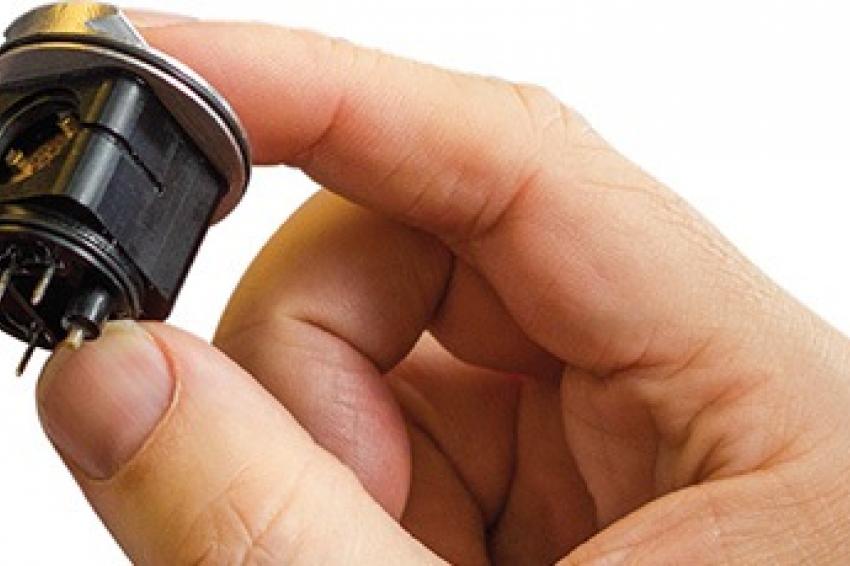Meeting the Needs of the First Responder in the Modern World
11.10.2013 - With the threat to society from toxic chemicals and explosives increasing exponentially, the need for portable devices that can detect and analyze a broad array of hazardous chemic...
With the threat to society from toxic chemicals and explosives increasing exponentially, the need for portable devices that can detect and analyze a broad array of hazardous chemicals and weapons at trace amounts has never been greater. The availability of compact analyzers that are rugged enough to meet military standards and reliable enough to be trusted in the field, as well as being simple to operate will have a significant impact on the safety and security markets.
Traditionally confined to centralized laboratories and operated by highly trained specialists, mass spectrometry systems still have a relatively untapped potential within the safety and security markets to provide hazardous chemical detection and analysis at the point of need. Over the past few decades, a number of smaller mass spectrometers have been developed. They typically attempt to shrink and ruggedize the same technological approach used in laboratory systems but while they demonstrate improvements in these areas, a gap in the market still exists for tools that are truly portable, rugged, accurate and easy to operate. The demand for these devices within the safety and security markets represents a significant opportunity, as well as a challenge for the mass spectrometry industry.
Miniaturization Successes
The successful miniaturization of technologies such as Raman, Ion Mobility Spectrometry and FTIR, combined with the clear demand for handheld devices that can detect and identify a wide range of substances suggests that the time for mass spectrometry to emerge from laboratories into the hands of the non-expert user has arrived. No single technique or approach can handle the wide array of detection and identification challenges faced by first responders in the modern world which means that it will be important for first responders to have a number of different technologies and tools at their disposal.
Raman spectroscopy identifies unknown chemicals by recording how their vibrating molecular bonds scatter incident laser light into distinct frequencies. The Raman technique has been used since 1928, undergoing many improvements to increase the sensitivity and flexibility of laboratory systems. By the mid-1990's, most Raman systems weighed 200lb, and though they were complicated and expensive, their analytical capability was still increasing.
However, due to their complex and fragile optical systems, they were difficult to run consistently and were not practical for use in field analysis. By taking a radically different approach to the technology - utilizing ruggedized optical components and design techniques from the telecom industry - Ahura Scientific developed a battery-operated Raman system which weighed just 2lbs. In 2004 Ahura shipped its first products and within a decade, many thousands of MilSpec-tested Raman systems were being used in desert locations to identify explosives in IEDs, to check in-coming raw materials at the loading docks of pharmaceutical plants and to identify illegal drugs on city streets around the world. The widespread use of this technology demonstrates the impact that the use of handheld devices can have.
Raman spectroscopy has a number of advantages including being highly selective (having the ability to differentiate between 10,000+ different compounds) and being able to identify compounds through glass or translucent materials, which can potentially reducing the risk of exposure to toxic chemicals. However, Raman is primarily used as a ‘bulk' technique which means that a relatively large amount of sample is required in order to make a measurement and it is rarely suitable for looking at low (or ‘trace') concentrations.
Ion Mobility Spectrometry (IMS) is an instrumental analytical method that separates ionized molecules according to size, mass and geometry. Previously based in the laboratory, handheld IMS products such as Smiths Detection's Lightweight Chemical Detector (LCD) or desktop systems such as the Itemizer 3 from Morpho Detection are currently widely deployed in the military and in airports respectively as ‘trace' techniques. This means that IMS can detect very low (ppb level) concentrations of target explosives or chemical weapons. Small, robust and relatively simple, IMS systems have been successfully used to give troops early warning of the presence of potentially harmful chemicals and explosives - helping to save lives.
This mature technology fulfils its current purpose however, compared to the forensic selectivity of mass spectrometry, IMS technology has a fundamental limitation in that it cannot move beyond detection of a limited number of chemicals to the broader array of threats we face today. It is crucial that the next generation of technology keeps up with the continually expanding and evolving list of chemicals that can be used as threats. Achieving this requires a leap in technological capabilities.
Government Investment
Despite current budget cuts, detection of chemical and explosive threats remains a priority. As an example, the US Government's Next Generation Chemical Detector (NGCD) program continues to gather speed, demonstrating the fact that there is a recognized need for investment in the development of new technology. Existing technology is no longer able to deal with the complexity of new chemicals and the NGCD program is designed to develop and procure detectors for Chemical Warfare Agents (CWAs), Toxic Industrial Chemicals (TICs), and Non-Traditional Agents (NTAs).
The detectors are intended for use by the military for a wide range of missions and the program will award contracts to multiple vendors for system prototypes. Procurement is due in 2016 for what is expected to be one of the most significant CBRN equipment contracts in the world. The ultimate aim is to replace existing technology with battery-operated, rugged devices that have the ability to deal with low levels of detection as well cover a wider range of threats. The creation of simple and purpose-built battery-powered mass spectrometry tools that are selective and sensitive could provide the ideal solution.
As a further example, in April 2013 908 Devices, an innovator in field-portable chemical analysis, entered into a strategic partnership with In-Q-Tel the independent strategic investment firm that identifies innovative technology solutions to support the missions of the U.S. intelligence community. The investment will contribute to 908 Devices' development of handheld mass spectrometry tools and demonstrates that the unprecedented chemical detection and analysis capabilities of this technology are aligned with national security needs and demand within the commercial market.
Portable Mass Spectrometry
Mass spectrometry is an analytical technique for measuring the mass of charged molecules and can be used to identify potentially toxic chemicals and explosives. Although the technology behind conventional systems is well established, due to their cumbersome size, fragility and complex operation and service, they are not suitable for use by untrained users operating in the field. It is these first responders such as the military, bomb squads, the police and fire fighters who would benefit dramatically from the use of truly portable mass spectrometry technology that could be deployed at the time and place it is needed most.
Existing ‘person-portable' mass spectrometry devices, or ‘luggables' as they are commonly referred to, have been developed over the past several decades as adjuncts to the capabilities of laboratory systems. Among the ‘luggable' products available on the market today are the Guardion and Hapsite systems from Torion Technologies and Inficon respectively. Both weigh around 30-35lbs, cost in the region of $100k+ and are considerably less rugged than typical military equipment.
The Hapsite chemical identification system is a portable gas chromatograph/mass spectrometer designed for on-scene detection, identification and quantification of toxic industrial chemicals. Used by environmental agencies, military units and dedicated response teams, Hapsite has enabled users to identify hazardous chemicals enabling them to make decisions faster and more reliably. Torion Technologies launched Guardion, in partnership with Smiths Detection in 2012, providing a measurement time of 3 minutes or less and the capability to run 30 samples on a single battery charge. Both products are improvements over laboratory systems for field operation but despite the fact that 10 years have passed between the development of these 2 products, there has not been a significant leap in the technology around size and weight, complexity, ruggedness or cost and there are still limitations. Conventional approaches to mass spectrometry are only driving improvements in these areas at a very slow pace.
Limitations
Existing portable mass spectrometry devices undoubtedly represent a significant step forward in the creation of portable mass spectrometers that are suitable for use in the field. However, from a user perspective they are still not delivering the ideal solution as they are still relatively complicated to use and are dependent on a user having completed comprehensive training to be able interpret the data. In addition, they are not fully hardened for routine operation in harsh conditions or for rough handling. Consequently, market penetration has been somewhat limited to small numbers of specialists.
The development of existing portable mass spectrometry instruments has always started with the components of complex laboratory systems being reduced in size and the software being simplified using shortcuts and then putting the system in a robust box. Despite now being smaller in size and slightly less complex, they are still relatively fragile and are therefore not always suitable for use in hostile environments. Rather than taking the existing systems and attempting to make them smaller, the tools need to be built from scratch to be purpose-built and as effective as possible.
Future Possibilities
Looking at how other technologies have been successfully miniaturized, can suggest how ultra-compact mass spectrometry tools could be developed to meet the needs of security personnel and first responders. The most successful miniaturized technologies have been developed with the needs of the end-user in mind and are focused on solving a specific problem rather than as general purpose analyzers. They deliver a radically different technological approach to the size, weight and power capabilities while also having the appropriate built-in ruggedness and reliability. Ultimately this technology delivers answers to non-expert users allowing technology specialists to operate in a broader support role.
Mass spectrometry is currently the gold standard for analytical testing in laboratories. Making the technology more widely available by moving analysis to the point of need will lead to a sea change in how chemicals and explosives can be detected. By bringing the analysis directly to the samples at the time and place it is needed will dramatically improve the capability of first responders to respond to threats effectively.
908 Devices is committed to bringing the powerful capabilities of mass spectrometry out of the confines of the laboratory into the hands of the first responder. The demand for handheld mass spectrometry tools will generate several billion dollars in sales over the next 10 years if tools that are sufficiently rugged and simple to use are developed. The expert team at 908 Devices are developing simple and purpose-built, battery-powered tools that provide chemical detection and analysis at the point-of-need - untethered from permanent facilities or mobile laboratories. Truly handheld and weighing only a few pounds, these analyzers are far beyond the unwieldy and complex ‘luggable' systems available today. 908 Devices' proprietary High Pressure Mass Spectrometry (HPMS) technology is a breakthrough that enables this leap in size, robustness and simplicity. The systems will give non-specialist field personnel analysis with extreme sensitivity - to the part-per-billion level - while simultaneously distinguishing hundreds of different chemicals.
Miniaturized mass spectrometry development is being driven by industry and customer needs such as those identified by the NGCD program, which will be the catalyst for additional large-scale commercial opportunities. The introduction of handheld devices that are both sufficiently sensitive and selective to a wide range of substances will open up a wealth of possibilities in the safety and security markets protecting the public against constantly evolving chemical, biological and explosive materials. Mass spectrometry has been waiting for a technological breakthrough. In this constantly evolving world, there has never been a better time to take the powerful capabilities of mass spectrometry out of the laboratories into the field.











